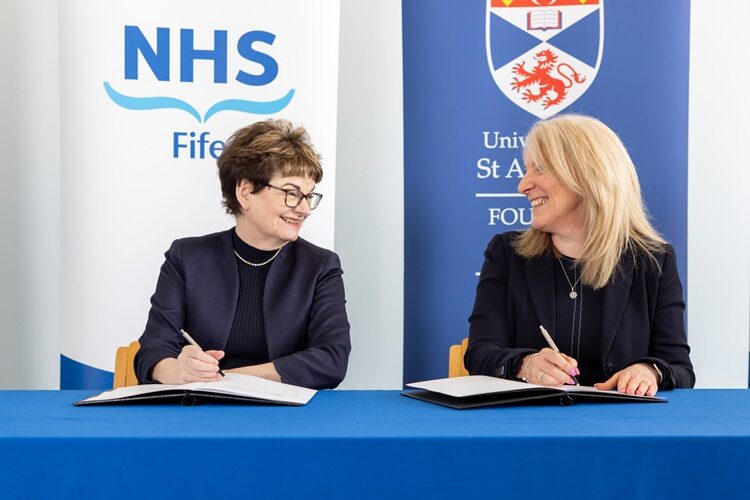Picture: Professor Dame Sally Mapstone FRSE (left), Principal and Vice-Chancellor, University of St Andrews, and NHS Fife Chief Executive Carol Potter sign the Memorandum of Understanding
A major new partnership between the University of St Andrews and NHS Fife will benefit patient care and medical research in the Kingdom of Fife, while boosting Scotland’s overall training provision for new doctors.
The new partnership, confirmed today (Tuesday 26 March) by NHS Fife and University leaders, follows a key decision by the Scottish Parliament in 2021 to remove a historic prohibition that had prevented St Andrews from awarding its own medical qualifications.
For years, St Andrews medical students had to leave Fife to undertake their clinical training elsewhere in the UK, under the supervision of other medical schools.
Now, students choosing to study medicine at St Andrews University will be able to do all their clinical training and complete their primary medical qualification in Fife.
Approval for the new St Andrews five-year medical degree came from the General Medical Council earlier this month, and both institutions have moved quickly to cement a partnership expected to bring a raft of benefits to healthcare and health services across the Kingdom.
The new partnership agreement between NHS Fife and the University of St Andrews will enhance education and training capacity, grow research capability, and provide a platform to enable delivery of new advances in healthcare, innovative discoveries, techniques and medications, resulting in better services and outcomes for patients throughout Fife.
Students will undertake their medical training with clinical teams across NHS Fife in a range of healthcare settings, including a network of healthcare innovation hubs within Fife’s community hospitals. The development of the medical programme will also see Fife move towards its goal of being recognised with teaching board status.
In addition to improving clinical teaching and research, the new partnership will also see NHS Fife work collaboratively with the University across a range of other areas, including environmental sustainability, the mutual use of estates and buildings, and a joint effort to help reduce ill-health and inequality within our local population.
